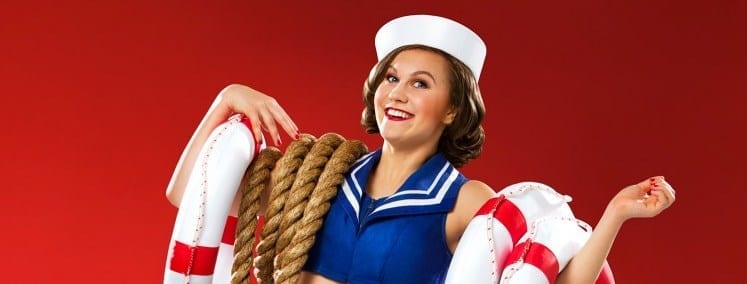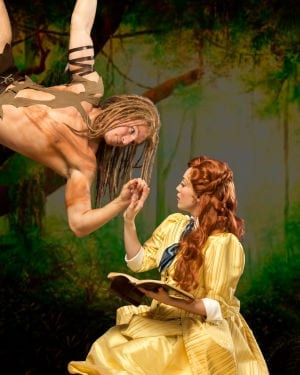NEW YORK CITY — A character in a Broadway musical arrives from Utah in a strange land. The Utahn, naïve and hopeful, must learn to adjust to the harsh reality that is life outside of the Beehive State bubble. No, I’m not talking about Elder Price in The Book of Mormon. Rather, I’m talking about Ruby, the exuberant protagonist of the Broadway production of Dames at Sea. As Ruby steps off the bus in New York City with just a pair of tap shoes and a dream, she bounces into show business and learns about the ups and downs of being a Broadway actress. The result is a production that is brimming with mirth and joy in nearly every scene.
Dames at Sea is the 1968 musical that spoofs the frothy, silly musicals of the 1930’s, with the greatest debt to 42nd Street. Nearly every musical theatre cliché is lovingly parodied, including the character who suddenly can dance impeccably, cheering up a depressed character with a song, the overly optimistic ingénue, and a group of show biz characters rallying around the cause of saving their show. In a way, Dames at Sea is like The Drowsy Chaperone avant la letre, with the creators (composer Jim Wise and lyricists and librettists George Haimsohn and Robin Miller) creating a show that pays homage to the musicals of yesteryear while also poking fun at their ridiculous plot lines and characters.
Headlining this revival is Eloise Kropp as the idealistic Ruby. Hailing from Centerville, Utah, Ruby is determined to be part of the magic of Broadway. In the hands of a lesser actress, Ruby would seem like an idiotic bumpkin, but Kropp’s expressive grin and excited eyes gave Ruby a naïve charm that was unceasingly endearing. This made me want to see Ruby succeed in the face of all her challenges—such as when she worried about losing her new love, Dick, or the stress of performing under intense pressures. Additionally, Kropp is a tap dancing dynamo, and the virtuosity that she and her fellow cast members displayed during the production makes the tap dancing in the 42nd Street film look pathetically simple.
No less impressive was Lesli Margherita as Mona Kent, the star of the fictional show-within-the-show. Margherita cranks up the zaniness in all her scenes, with the her funniest moments being the songs “The Beguine” (a duet with John Bolton, who plays The Captain) and “That Mister Man of Mine.” In the former song Margherita adopts a ridiculously over-the-top Spanish accent that drew great laughs from the audience. In “That Mister Man of Mine” her facial expressions humorously undermined the passion and seriousness of the traditional Broadway torch song.
Mara Davi in the role of Joan served as the stable bridge between the temperamental diva Mona and the overly optimistic Ruby. Davi gave Joan a touch of power; her authority came from her strong physical presence and her experience as a performer in many prior flops. This made the other characters in the play trust Joan and made the zany action grounded in reality. Davi also led the powerful first act finale, “Good Times Are Here to Stay” with ease, finding the perfect mix of humor and earnestness, and giving the audience plenty of reason to come back to the show after intermission.
The men of Dames at Sea were well matched with their female castmates, with Cary Tedder as Dick (another Utahn character) as an impressive standout. The rapid fire dialogue between Tedder and Kropp in Tedder’s first scene showcased his comedic talents and the play’s willingness to shine a spotlight on the sort of ludicrously coincidental events in 1930’s musicals. He also embraced the play’s absurdity in the delightful “It’s You” when he engages in a romantic dance with Ruby—even though the two just met. Danny Gardner as Lucky (Dick’s friend and shipmate in the Navy) is a master of the goofy grin, especially in the title song and the cutesy and saccharine “Choo Choo Honeymoon.” Finally, John Bolton’s performance as Hennesey and The Captain brought a hint of gravitas to the play. Hennesey’s financial problems as the producer of the play-within-the-play drive the action for the last two-thirds of the show. Additionally, The Captain’s position as Lucky and Dick’s commanding officer means that Bolton is shouldered with handling nearly all of the seriousness of Dames at Sea. Thankfully, he handles this job breezily and keeps the action moving so that the audience can make it to the next sight gag or laugh line.
And there are plenty of laugh lines. From Ruby’s excited offer to help move seven tons of costumes, to the silly haughtiness of Mona Kent, to the ridiculous letter that Ruby writes for FDR in “The Sailor of My Dreams,” director Randy Skinner clearly gets the style of humor required by the script. Skinner also created the peppy choreography, which included the romantic “It’s You,” and the soothing “Choo Choo Honeymoon,” both of which showed that Skinner was a master of more than just spirited tap dancing. Finally, I commend Skinner for his ability to maintain a quick pace to the show; the two-hour production feels like it lasts less than half that time.
The visual elements of the production are period appropriate. Costume designer David C. Woolard recreated the glitz of the musicals of the era by having the play-within-the-play’s costumes dazzle with sequins and bright colors, especially in the first and final numbers of the overall show. Woolard used more subdued colors for the characters to wear when they weren’t performing, which was brilliant. This served as a subtle reminder of which parts of the play were the characters’ reality. Anna Louizos’s set designs were the most realistic element of the play, faithfully representing backstage at a Broadway theater and the deck of a Navy battleship. Finally, Ken Billington and Jason Kantrowitz were deft in their lighting designs as they contributed to the dreamy mood of “It’s You” by bathing the actors in blue and pink tones. On the other hand, the two designers amped up the passion of “The Beguine” with deep red light spilling out from the ship’s portals and from the cyc.
Finally, I appreciate the way Haimsohn and Miller’s script handles the Utah references. Too often the entertainment industry portrays Utahns in offensive ways, often as simple-minded rubes or as hypocritical religious nuts who are covering some dark secret. But Dames at Sea is completely respectful in its treatment of Utahns. Yes, Ruby is idealistic, and, yes, Dick has a “gee whiz” character to him. But this is merely because they’re from a small town in the 1930’s, not because they’re from Utah. There are no jokes ridiculing them for their small town way of life, and there are not even any indications of whether the two characters are Mormon (though, given the time period, it is likely that one or both are).
So, forget your worries and come to New York City to pass a few hours at a Broadway musical with endearing characters and story. Dames at Sea is a sure bet for Broadway audiences looking for a show that is as clean, happy, and exciting as Ruby is.








